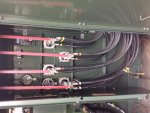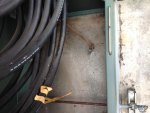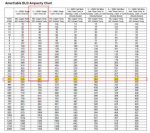We are replacing a 2500kva, 21kv x 277/480 pad mount transformer. On the secondary side of the transformer, there is 373 Kcmil DLO cable (RHHW) that connects the transformer to 4000A bussduct (see attached pictures). There are (7) conductors per phase. After looking at my DLO ampacity chart (similar ampacity as 310.15(B)(16-17) but with odd DLO sizes), I don't see how they made the 373 work for a 2500kva transformer (3010A @ 480V) unless they are using the free air rating of the cable. I know that the utilities tend to use non standard cabling with they do this, but this is not utility. This is customer owned primary equipment. I'm trying to find out if the free air rating can be used in this application because the transformer is large open structure and the transition can is large and short. Once we replace the transformer, we own what is there and need to make sure we address any existing issues may be present.
You are using an out of date browser. It may not display this or other websites correctly.
You should upgrade or use an alternative browser.
You should upgrade or use an alternative browser.
Free Air Ampacity Rating???
- Thread starter Richard S
- Start date
- Status
- Not open for further replies.
I don't see how either.... I don't see how they made the 373 work for a 2500kva transformer (3010A @ 480V) ...
First, are you sure it's RHHW, i.e. with two H's? I ask because the NEC does not recognize the wire type. It recognizes RHH, RHW, and RHW-2... but not RHHW. See Table 310.104.
Next, is that a transition can or a wireway. If a transition can then there is no field wiring. As such, none of the Article 310 ampacity tables apply. And none list RHHW anyway.
If we get past these first two hurdles, we might be able to construe some facts to see some light through that tunnel there.
I don't see how either.
First, are you sure it's RHHW, i.e. with two H's? I ask because the NEC does not recognize the wire type. It recognizes RHH, RHW, and RHW-2... but not RHHW. See Table 310.104.
Next, is that a transition can or a wireway. If a transition can then there is no field wiring. As such, none of the Article 310 ampacity tables apply. And none list RHHW anyway.
If we get past these first two hurdles, we might be able to construe some facts to see some light through that tunnel there.(pun intended)
I believe it is rated both RHH & RHW. I'm not quite sure how determine what a transition can would be. These are frequently installed by local utility (PG&E) to transition from pad mount transformers to bussduct. They require bussduct on 3000 & 4000A services. When companies install there own primary service and replace utility transformers with there own, these transition cans frequently remain.
Those types are good to go... just not RHHW (if the type even exists).I believe it is rated both RHH & RHW...
The "can" can really be a can or it can be a wireway
Nevertheless, ampacity is always capped at the terminal temperature limitation, which is always determined per Table 310.15(B)(16). So the absolute highest possible ampacity for any 600/1000V conductor is the value in the 90°C column corresponding to the conductor size. For 350kcmil copper, that's 350A... and with 7 of 'em, only looking at 2450A. Would need at least 2 more per leg to break 3000A. :weeping:
- Status
- Not open for further replies.






